The easiest no fail, no-knead sourdough discard bread is mixed together the night before, fermented overnight, and baked in the morning. This recipe has a soft, chewy crumb with a crusty exterior, and that tangy sourdough taste – without all the work.

I know, I know, this recipe isn’t a true sourdough bread recipe. While it does contain sourdough discard, it also contains commercial yeast.
This does two things. It makes it a no-fail recipe as the yeast helps the bread rise whether or not your sourdough starter is active enough. Which then, in turn, allows you to forego the kneading (or stretch and folds) in this recipe.
Sourdough discard bread is the perfect way to use up that extra sourdough discard. Serve it alongside soup, your favorite pasta dish, or make a robust sandwich.
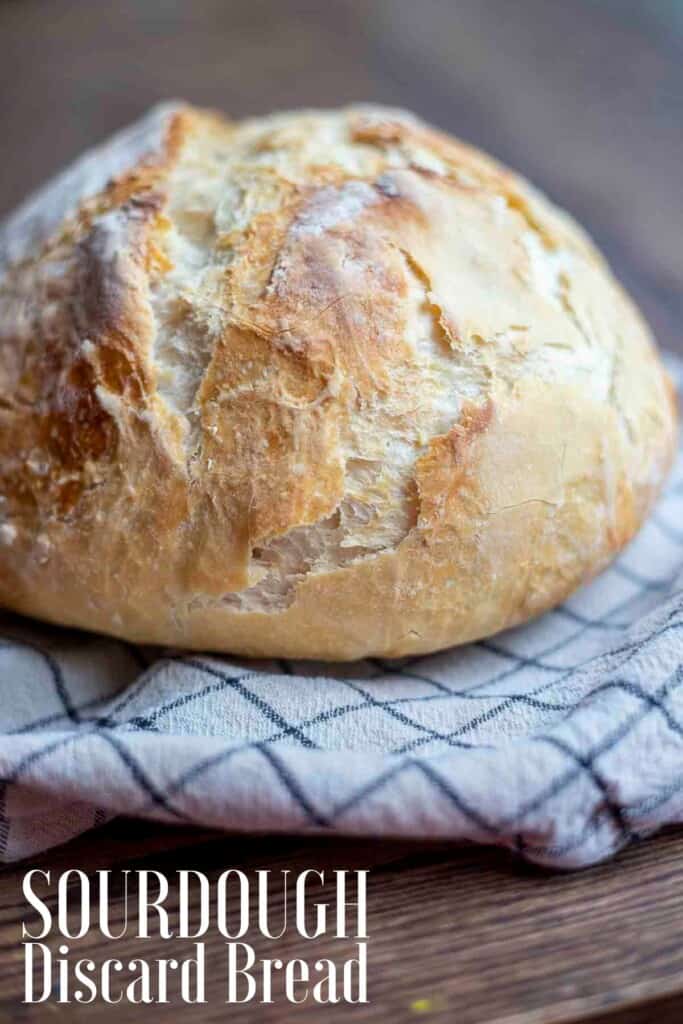
Why you will love this recipe:
Super easy: Mix it up, leave it overnight, shape and bake in the morning. About ten minutes of hands on time allows you to have the yummiest bread.
Delicious: That delicious sourdough tanginess, but without all the kneading and stretching.
Budget friendly: I’m always looking for healthy ways to stretch the grocery budget. This recipe is a great one, especially if you have a super busy schedule.
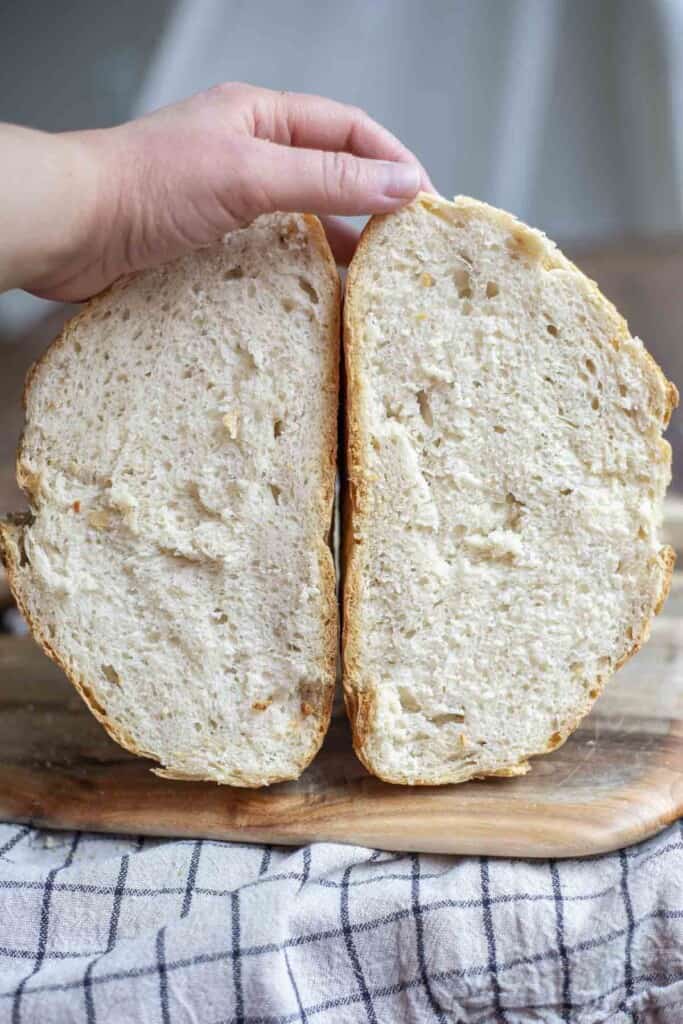
Tips For Making Sourdough Discard Bread:
- To make this bread fluffier and rise better, make sure not to skip adding tension to the dough when shaping. You can easily just plop it onto parchment paper and bake and still get a decent quality loaf, but taking an extra 2-3 minutes to pull the dough edges to the center and then cupping your hand and pulling the dough towards you on the countertop makes a huge difference.
- I like using active dry yeast for this recipe because it can have a slightly slower rise compared to instant yeast.When dissolving the yeast, make sure the water is around 110 degrees. Too hot and you run the risk of killing the yeast.
- To get that crusty exterior, you will need to bake the bread in a dutch oven.
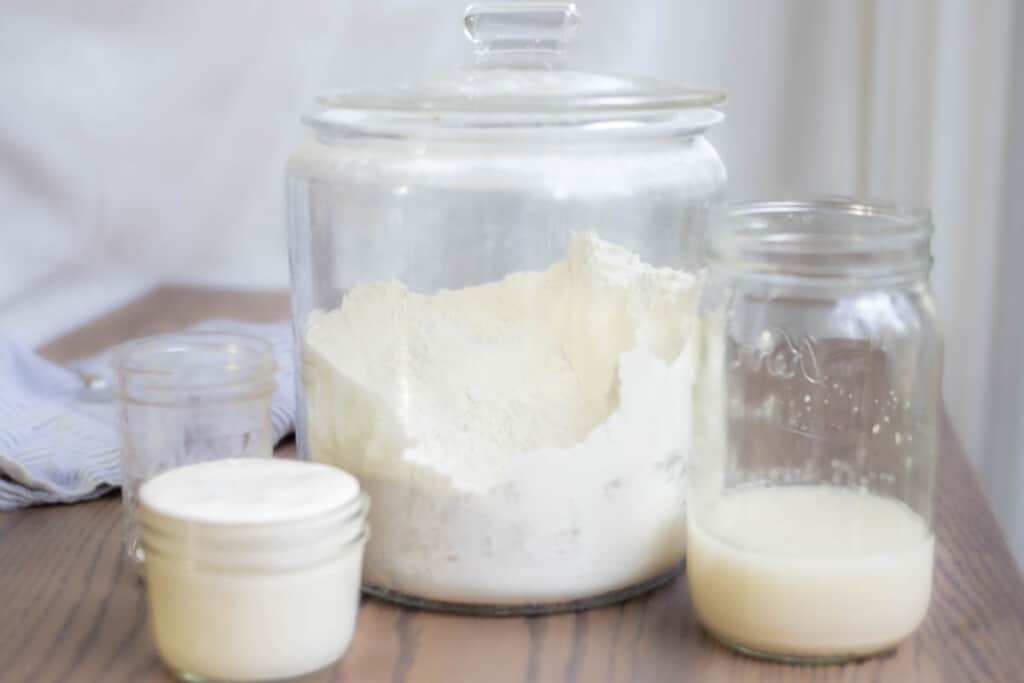
Ingredients:
All-purpose flour: If using freshly milled flour, choose hard, white wheat berries.
Active dry yeast
Sourdough discard: This is sourdough starter that hasn’t been fed in at least 12 hours. It is the portion you would typically just toss before feeding the starter. Active starter could also be used, but you will have a less tangy flavor.
Water: Preferably filtered.
Salt: I use sea salt.
This post contains affiliate links, which means I make a small commission at no extra cost to you. See my full disclosure here.
Tools you will need:
Large spoon or silicon spatula
Parchment paper
FAQ:
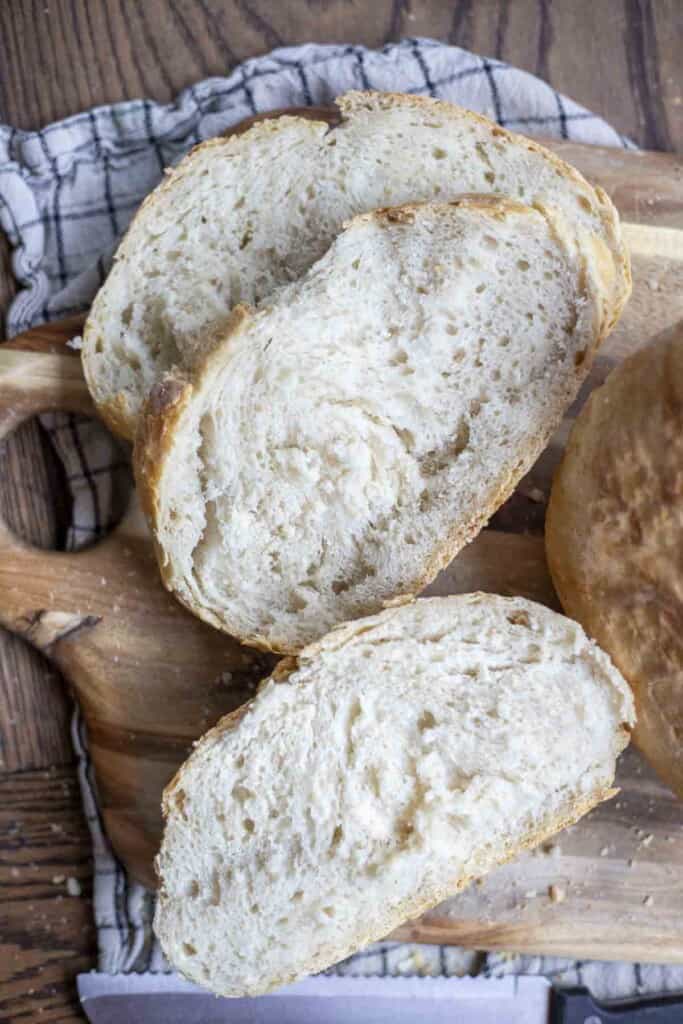
What can I use my sourdough discard for?
Sourdough discard is super versatile and can be used for so many recipes. Some options include muffins, quick breads (like pumpkin, banana, zucchini, etc.) pancakes, waffles, crackers, cakes, and more.
What is the difference between active sourdough and discard?
Active sourdough starter is starter that has been fed water and flour and allowed to sit until it is bubbly and about doubled in size. Sourdough discard is after the starter has peaked, and it has started to come down. It is the portion that you would typically throw away before feeding.
Although, at this point, I never throw away discard because it can be used in so many things.
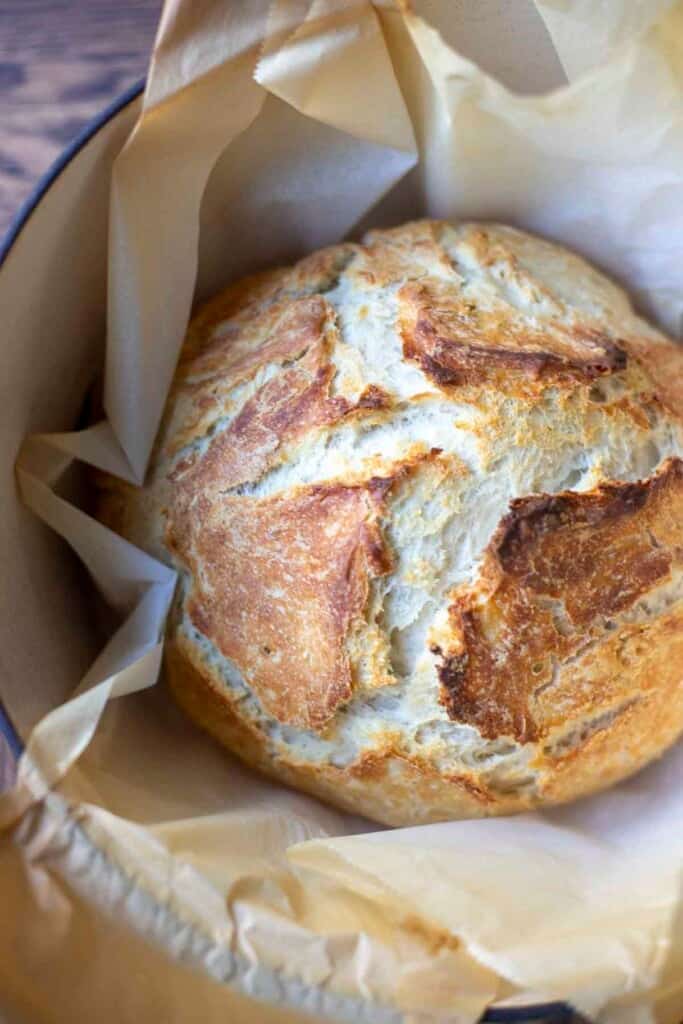
How To Make Sourdough Discard Bread:
Warm water to about 110 degrees. Add active dry yeast and stir. Allow to sit for about five minutes until it gets nice and bubbly.
In a large bowl, whisk together salt and flour.
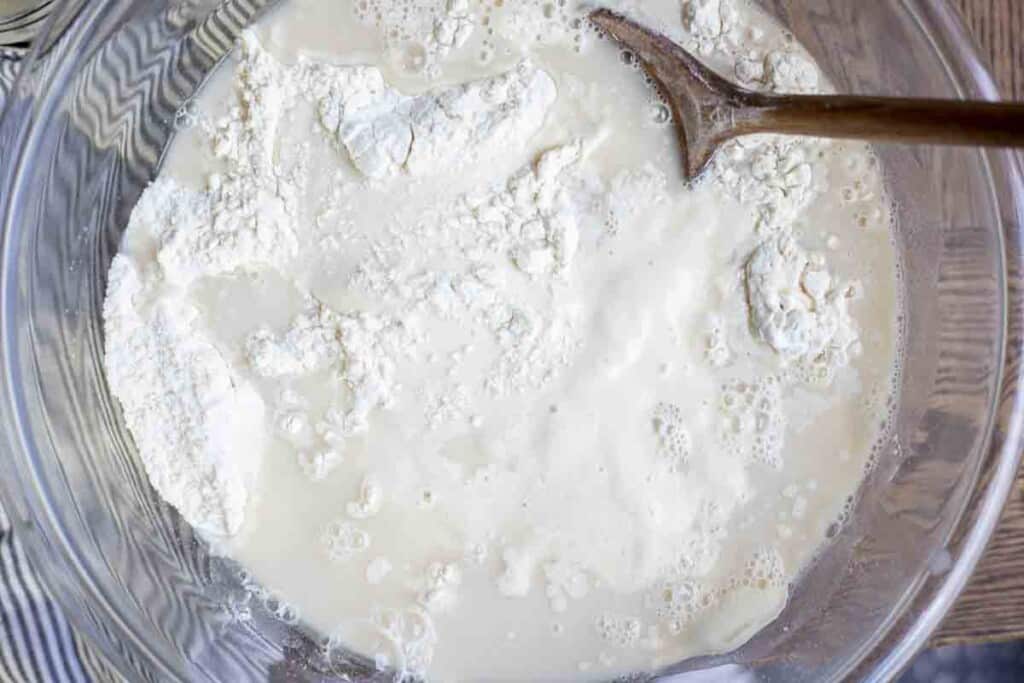
Add sourdough starter and yeast/water mixture.
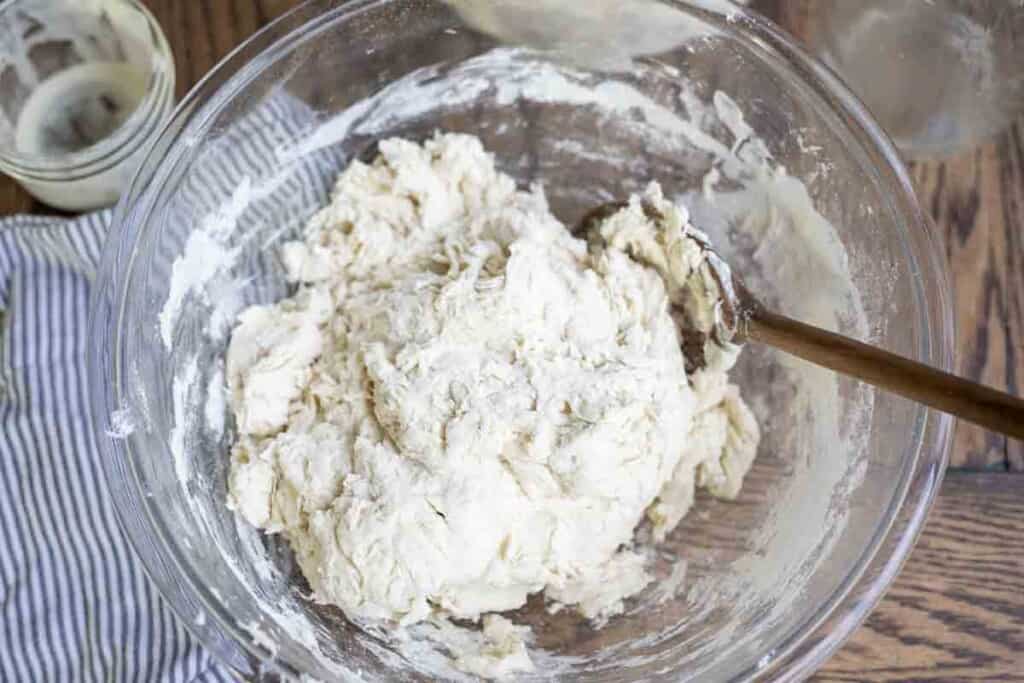
Mix well with a large spoon or silicon spatula. It will be a shaggy dough.
Cover with a lid or plastic wrap and leave at room temperature for around 12 hours.
The next day, preheat the oven to 450. Place your dutch oven and lid into the oven to preheat.
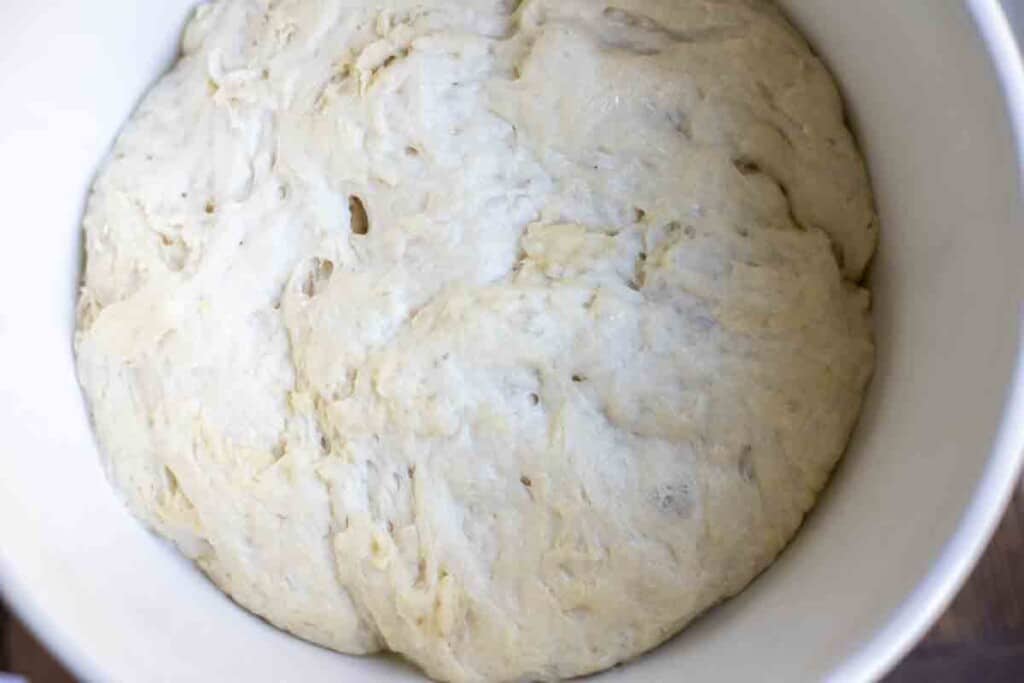
Turn the dough on a lightly floured surface. The dough will be pretty sticky.
Shape into a ball by pulling the sides and bringing them into the center. I do this about 4-6 times. Flip the ball over, seam side down.
Taking your hands, grab the dough and pull it towards you a few times. This adds tension (as does the last step) to the dough, which helps the dough rise more during baking.
Place the dough on parchment paper. Cover with a towel and allow to rise in a warm place for 30 minutes to an hour. The stove top works wonderfully for this as your oven preheats.
Slash with a lame or knife (if desired) and place the parchment paper and dough into the dutch oven and cover with a lid.
Place the dutch oven into the oven and turn the heat down to 400 degrees. Bake with the lid on for 30 minutes, then remove the lid and bake for about 20-30 minutes until golden brown.
Allow to cool completely before slicing. I usually just allow it to cool in the dutch oven.
Storage:
Store uncut bread in a paper or linen bag. Once cut, store cut side down on a cutting board lightly covered or in a storage bag. A zip-lock bag will also work.
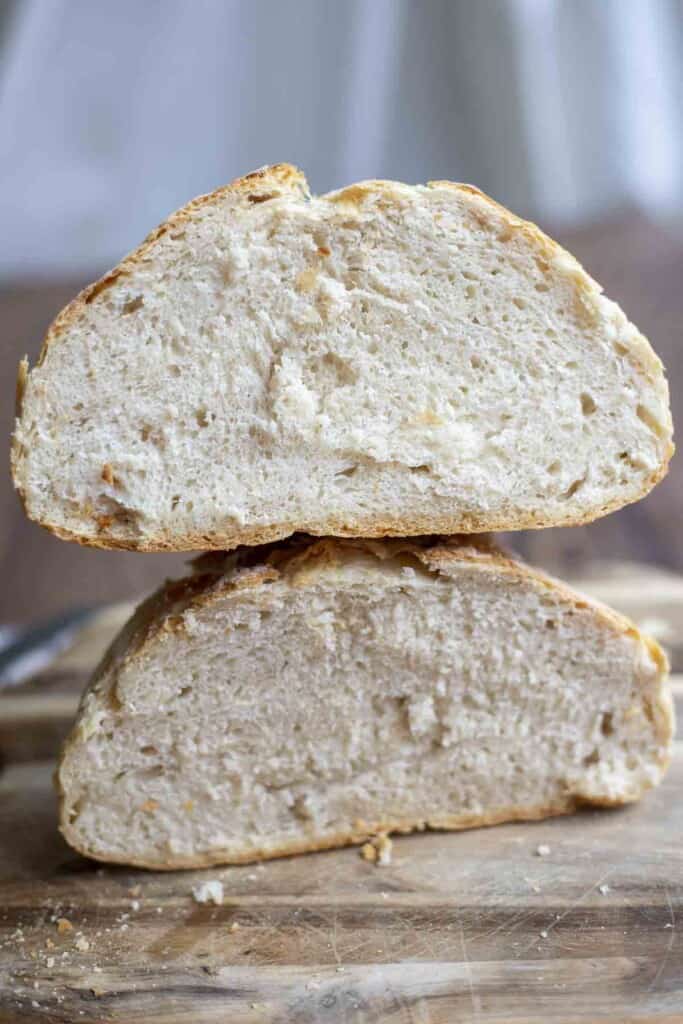
Baker’s Schedule
8 PM: Mix up the dough and cover. Leave at room temperature.
8 AM the next day: Preheat oven with dutch oven and lid inside. Turn dough out onto a lightly floured surface. Shape. Place on parchment paper and cover with a towel for 30 minutes.
9 AM: Bake, then allow to cool before slicing.
Find More Sourdough Recipes:
- Bread Machine Sourdough Bread Recipe
- Spelt Sourdough Bread
- Sourdough Rye Bread
- Sourdough Pumpkin Bread
- Pumpkin Sourdough Bread
If you try this recipe and love it, I would love if you could come back and give it 5 stars!
Sourdough Discard Bread
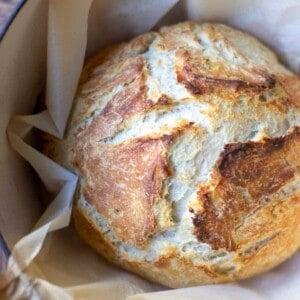
Ingredients
- 1 1/4 cup water, 295g
- 2 1/2 teaspoons yeast or one packet, 7g
- 2 teaspoons salt, 10g
- 1 cup sourdough discard, 255g
- 4 cups all-purpose flour, 575g
Instructions
- Warm water to about 110 degrees. Add active dry yeast and stir. Allow to sit for about five minutes until it gets nice and bubbly.
- In a large bowl, whisk together salt and flour.
- Add sourdough starter and yeast/water mixture.
- Mix well with a large spoon or silicon spatula. It will be a shaggy dough.
- Cover with a lid or plastic wrap and leave at room temperature for around 12 hours.
- The next day, preheat the oven to 450. Place your dutch oven and lid into the oven to preheat.
- Turn the dough on a lightly floured surface. The dough will be pretty sticky.
- Shape into a ball by pulling the sides and bringing them into the center. I do this about 4-6 times. Flip the ball over, seam side down.
- Taking your hands, grab the dough and pull it towards you a few times rotating the dough after each pull. This adds tension (as does the last step) to the dough, which helps the dough rise more during baking.
- Place the dough on parchment paper. Cover with a towel and allow to rise in a warm place for 30 minutes to an hour.
- Slash with a lame or knife (if desired) and place the parchment paper and dough into the dutch oven and cover with a lid.
- Place the dutch oven into the oven and turn the heat down to 400 degrees. Bake with the lid on for 30 minutes, then remove the lid and bake for about 20-30 minutes until golden brown.
- Allow to cool completely before slicing
Notes
- To make this bread fluffier and rise better, make sure not to skip adding tension to the dough when shaping. You can easily just plop it onto parchment paper and bake and still get a decent quality loaf, but taking an extra 2-3 minutes to pull the dough edges to the center and then cupping your hand and pulling the dough towards you on the countertop makes a huge difference.
- I like using active dry yeast for this recipe because it can have a slightly slower rise compared to instant yeast.
- When dissolving the yeast, make sure the water is around 110 degrees. Too hot and you run the risk of killing the yeast.
- To get that crusty exterior, you will need to bake the bread in a dutch oven.
Nutrition
Nutrition information is automatically calculated, so should only be used as an approximation.
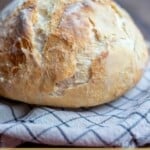
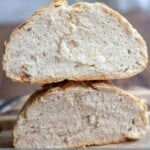
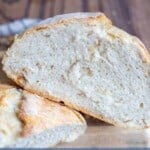
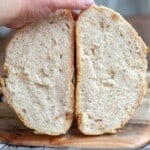
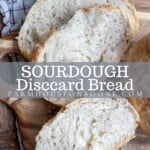

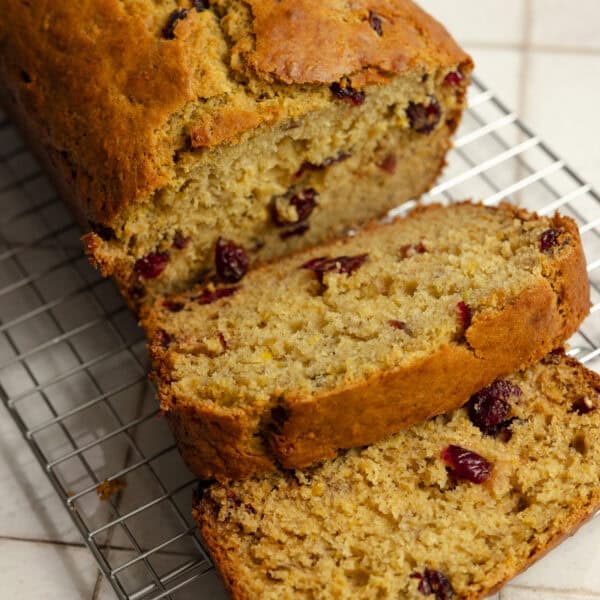

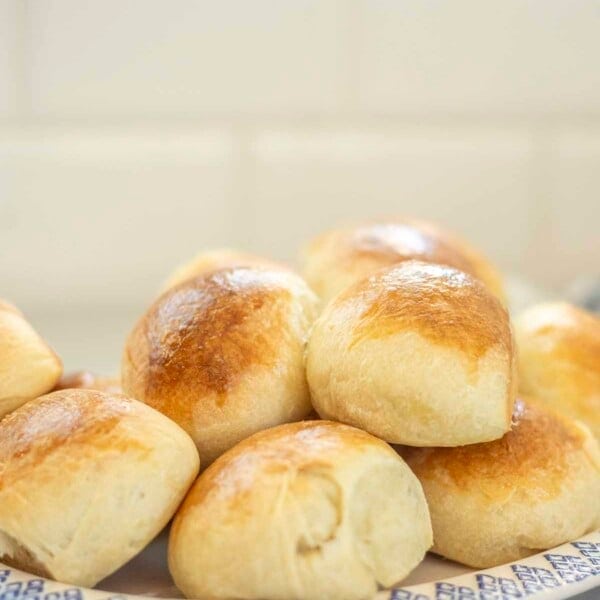






Can I make this recipe in a loaf pan? I don’t currently have a dutch oven (I know, I know) but wondering if this will work ok if I divided into two and baked in loaf pans? Thanks!
Probably. I’ve never tried it, but it should work fine. It won’t be crusty unless you add a lot of steam to the oven.
curious as to why AP Flour and not Bread Flour? Do you have a recipe adjustment if we use bread flour?
Either will work. Most people already have all-purpose in their pantry. Bread flour is typically preferred for bread because it has more protein and gluten structure, since this bread isn’t kneaded that gluten formation doesn’t really happen.
Absolutely amazing.
Glad you enjoyed the recipe!
Lisa, do you have a video somewhere showing what you mean by step #9? I really don’t get what you are doing there. Or if somehow you could elaborate. Thanks!
My whole process is here https://www.youtube.com/watch?v=kp3ZYkzbg9Q&t=160s Hope that helps!
My yeast did not bubble. Package Instructions say 1/4 cup warm water your instructions say 1 1/4. Is that accurate? I measured temp of water and it was exact 110.
1 1/4 is correct. Every recipe is different for how much water to use. 1/4 may be the recommendation from the package to rehydrate and activate. My guess if your yeast isn’t getting bubbly at all and you haven’t recently purchased it, it may be dead.
I had the same problem when activating the yeast using 11/4 cup of water at the correct temp.it did not activate. Instead I used 1/4 cup of the correct temp water and added the yeast and some sugar ,(as per yeast instructions) and the yeast activated beautifully. I then added the remaining water to the yeast and then to the flour.
I’ve made this recipe several times now and I absolutely love it! It’s perfect for my constantly growing starter and helps me feel like I’m not wasting such healthful foods!
Yay! That is so wonderful to hear!
Have you done this as a normal sourdough risen loaf without the yeast? Would it need more active starter than the discard called for or the same? My kids love this one a lot more than the standard sourdough loaves. I’m trying to phase out the yeast and stick with the healthier and more sustainable starter but having a little trouble with the transition.
Thanks for the great content!
Hey Kate. Here is no no-knead sourdough recipe without yeast: https://www.farmhouseonboone.com/no-knead-sourdough-bread I have found that if not using commercial yeast sourdough dough does need to be worked a bit to get it nice and fluffy.
I am SO excited to try this!! I love making sourdough, but during the week, I often don’t have time to do all the stretching and folding.
I hope you enjoy it!
I accidentally bought Instant yeast – how might it react if I used it?
I came to the comments to ask the same thing! I don’t know if you solved it for yourself, but I found success through some tips from a youtube video where the biggest difference was using LUKEWARM water when using instant yeast. The first two times my water was definitely too warm and absolutely nothing happened. I also used 1TB of yeast and added 1TB of sugar (per the video suggestions). Then within 10 minutes it was super bubbly.
https://www.youtube.com/watch?v=SrHII5rsBEU
I use instant yeast exclusively, and bake a lot of no-knead, slow rise artisan bread. The quantity called for in this recipe is over the top for a slow rise bread. After one hour, the dough had risen to the top of the bowl. I moved it to the fridge for the rest of the night. Everything turned out in the end. The bread was tasty and had a nice crumb. But I question the amount of yeast if you’re going to leave it on the counter to rise. For my no-knead bread, I use 1/4 tsp of yeast for 430 grams of flour. As I said, this recipe worked out, and next time I will either cut down the amount of yeast, or place the dough in the fridge for a slow, refrigerated overnight rise.
The recipe called for active dry yeast in that amount because it does have a slower rise than instant yeast. I made this dough last night with one tsp of instant yeast, plus the discard can still have some activity. First time making this recipe, excited because I was out of loaves in my fridge to bake for the family and didn’t have time to feed the starter, make a hearty loaf with stretch and fold technique, etc., so I’m hopeful that this is a great way to have a fresh fermented loaf anyway. I also decided to use bread flour because I don’t really like my AP flour that I have stocked right now. Here’s hoping all goes well!
So how did it turn out
I used active dry and it was definitely over fermented and collapsing after six hours.
Same here
Can this dough sit a little longer than 12 hrs? I did not time that right getting it ready lol
Possibly, but if it is too warm in your house it can over ferment. It can sit for days in the fridge though!
Would a day in the fridge be fine? I’m mixing the dough now and won’t be able to bake it for another 24 hours! Or should I leave it another day or two if in the fridge?
Up to 24 hours should be fine. I have tried keeping it in the fridge for a few days and it didn’t get as fluffy.